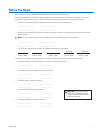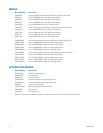
10 C623M-C (3/05)
Description
The DX8000 Series digital video recorder (DVR) represents the next generation of high-performance, PC-based digital video recorders. It is
designed for those users who demand an easy-to-operate, yet innovative DVR. The DX8000 features built-in video motion detection, alarm-based
recording, and relay output controls. Models range from an eight-channel unit with 80 GB of storage to a sixteen-channel unit with 1 TB of
storage. Fully implemented networking capabilities allow remote administration, playback, and export using the included PC client application.
Live viewing is supported on a variety of client platforms including Internet browsers and Pocket PC-compatible handheld devices. Versatile high-
speed search operations include time and date, event list, thumbnail, and intelligent pixel searching. Extensive scheduling features allow for
customized weekday, weekend, and special event recording. The DX8000 offers users a highly intuitive and ergonomically designed interface
that provides simple and efficient access to all setup and operation functions. Backup operations are straightforward with a number of available
optical, magnetic, and network-attached media options. Overall, the DX8000 combines a feature-rich security platform with a flexible and
intuitive user interface offering an unprecedented level of functionality.
WHAT IS A DVR?
A digital video recorder (DVR) is a video recording and playback device. A DVR incorporates all
of the essential capabilities of a VCR but adds significant advantages. Like a VCR, video is
recorded from one or more cameras and stored for later playback and retrieval; however, in a
DVR, video data is recorded and stored on a hard disk instead of magnetic tape. Storing video in
this manner facilitates instant, random access to data, as opposed to sequential access
inherent to tape-based recording. This means no fast-forwarding or rewinding is necessary to
locate the data a user wants to view or export. Another key advantage over tape is decreased
maintenance. With no need to replace tapes, DVRs with hard disks can be left unattended for
extended periods of time. Since video remains in the digital domain, data is easy to store,
transport, and manipulate. Unlike analog video recordings, digital data does not suffer from a
loss in quality when copied or moved from device to device. Because DVRs rely on hard disks
instead of tape, data storage is virtually unlimited. Video data can also take advantage of
compression technology to increase the efficiency of storage media. Modern DVRs, such as the
DX8000, allow users to record, play back, and view live video simultaneously. Keeping data
digital means video can be easily backed up to a variety of storage media. It also means that
alphanumeric information, such as date, time, and transaction statistics, can be synchronously
recorded with video.


















